Report on Effective Communication Theories, Models, and Strategies
VerifiedAdded on 2020/06/06
|31
|10507
|488
Report
AI Summary
This report delves into the multifaceted realm of effective communication, commencing with an exploration of prominent communication theories. It begins by examining Aristotle's linear model, highlighting its speaker-centric approach and its strengths in public speaking while also acknowledging its limitations, such as the absence of feedback. The report then progresses to the transactional communication model, emphasizing its dynamic and reciprocal nature, where both sender and receiver exchange roles and influence each other. It explores the advantages of this model in interpersonal communication while pointing out potential challenges, such as the need for shared understanding and the impact of noise. The Shannon model, with its focus on technical aspects of information transmission, is also discussed, including its components like sender, transmitter, channel, and receiver, alongside the concept of noise and its implications for communication effectiveness. Furthermore, the report explores the role of social media integration theories in the communication landscape. The research methodology section outlines the research philosophy, paradigm, approaches, strategy, choices, time horizons, and design, including data collection methods such as focus groups, observations, interviews, and questionnaires, and emphasizing the importance of research ethics and sampling strategies. The literature review covers the history of communication theories and their evolution, the key elements of each model, and their respective strengths and weaknesses, aiming to provide a comprehensive understanding of effective communication strategies.
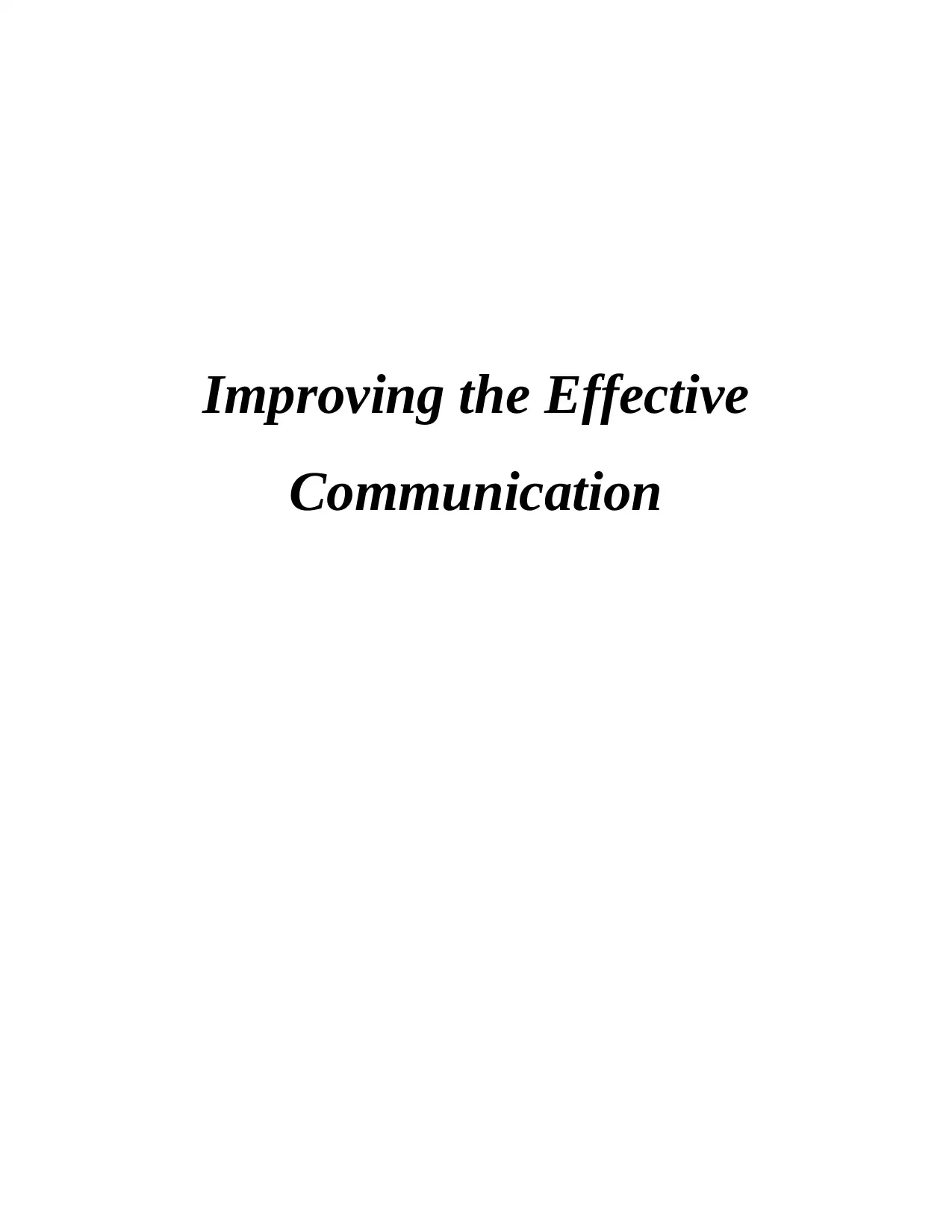
Improving the Effective
Communication
Communication
Paraphrase This Document
Need a fresh take? Get an instant paraphrase of this document with our AI Paraphraser
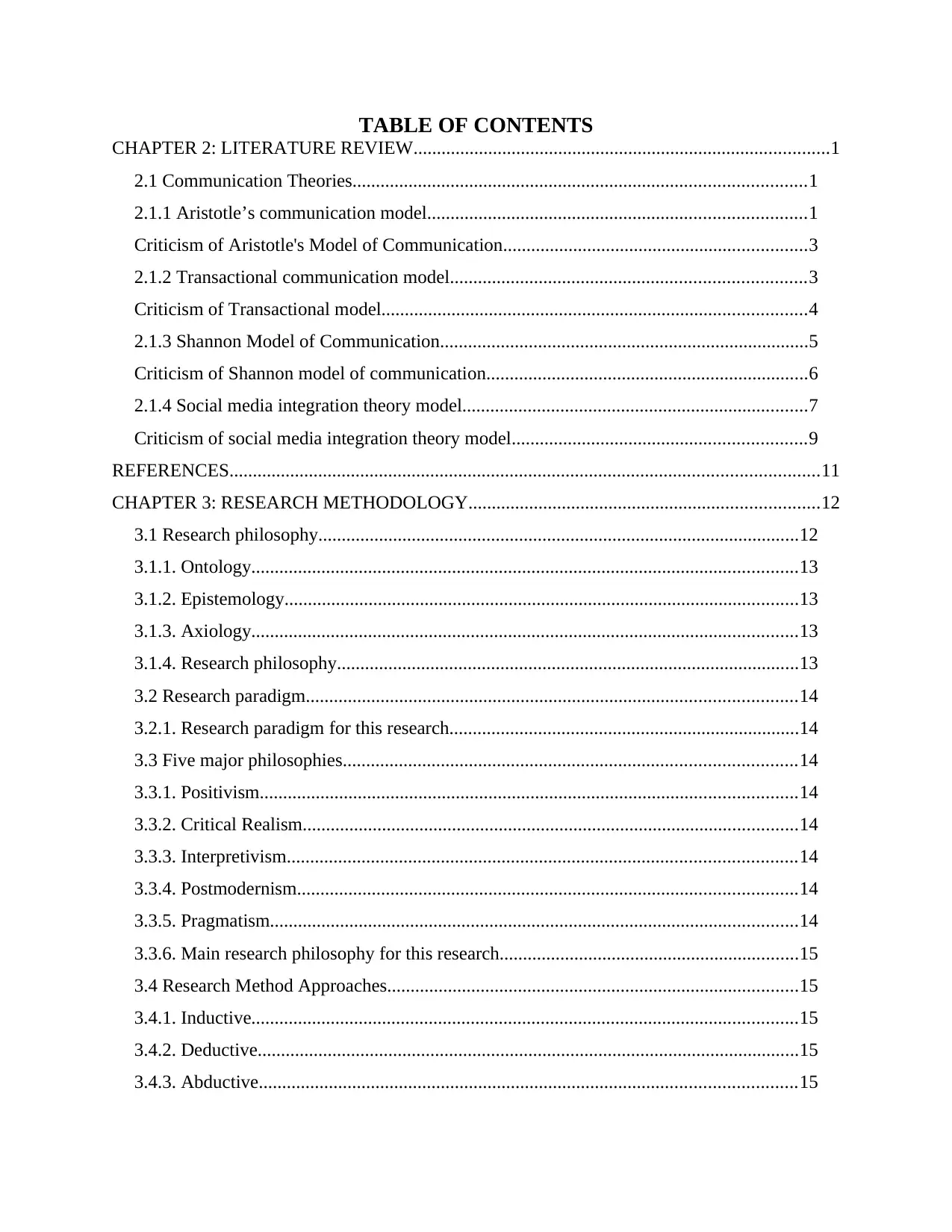
TABLE OF CONTENTS
CHAPTER 2: LITERATURE REVIEW.........................................................................................1
2.1 Communication Theories.................................................................................................1
2.1.1 Aristotle’s communication model.................................................................................1
Criticism of Aristotle's Model of Communication.................................................................3
2.1.2 Transactional communication model............................................................................3
Criticism of Transactional model...........................................................................................4
2.1.3 Shannon Model of Communication...............................................................................5
Criticism of Shannon model of communication.....................................................................6
2.1.4 Social media integration theory model..........................................................................7
Criticism of social media integration theory model...............................................................9
REFERENCES..............................................................................................................................11
CHAPTER 3: RESEARCH METHODOLOGY...........................................................................12
3.1 Research philosophy.......................................................................................................12
3.1.1. Ontology.....................................................................................................................13
3.1.2. Epistemology..............................................................................................................13
3.1.3. Axiology.....................................................................................................................13
3.1.4. Research philosophy...................................................................................................13
3.2 Research paradigm.........................................................................................................14
3.2.1. Research paradigm for this research...........................................................................14
3.3 Five major philosophies.................................................................................................14
3.3.1. Positivism...................................................................................................................14
3.3.2. Critical Realism..........................................................................................................14
3.3.3. Interpretivism.............................................................................................................14
3.3.4. Postmodernism...........................................................................................................14
3.3.5. Pragmatism.................................................................................................................14
3.3.6. Main research philosophy for this research................................................................15
3.4 Research Method Approaches........................................................................................15
3.4.1. Inductive.....................................................................................................................15
3.4.2. Deductive....................................................................................................................15
3.4.3. Abductive...................................................................................................................15
CHAPTER 2: LITERATURE REVIEW.........................................................................................1
2.1 Communication Theories.................................................................................................1
2.1.1 Aristotle’s communication model.................................................................................1
Criticism of Aristotle's Model of Communication.................................................................3
2.1.2 Transactional communication model............................................................................3
Criticism of Transactional model...........................................................................................4
2.1.3 Shannon Model of Communication...............................................................................5
Criticism of Shannon model of communication.....................................................................6
2.1.4 Social media integration theory model..........................................................................7
Criticism of social media integration theory model...............................................................9
REFERENCES..............................................................................................................................11
CHAPTER 3: RESEARCH METHODOLOGY...........................................................................12
3.1 Research philosophy.......................................................................................................12
3.1.1. Ontology.....................................................................................................................13
3.1.2. Epistemology..............................................................................................................13
3.1.3. Axiology.....................................................................................................................13
3.1.4. Research philosophy...................................................................................................13
3.2 Research paradigm.........................................................................................................14
3.2.1. Research paradigm for this research...........................................................................14
3.3 Five major philosophies.................................................................................................14
3.3.1. Positivism...................................................................................................................14
3.3.2. Critical Realism..........................................................................................................14
3.3.3. Interpretivism.............................................................................................................14
3.3.4. Postmodernism...........................................................................................................14
3.3.5. Pragmatism.................................................................................................................14
3.3.6. Main research philosophy for this research................................................................15
3.4 Research Method Approaches........................................................................................15
3.4.1. Inductive.....................................................................................................................15
3.4.2. Deductive....................................................................................................................15
3.4.3. Abductive...................................................................................................................15
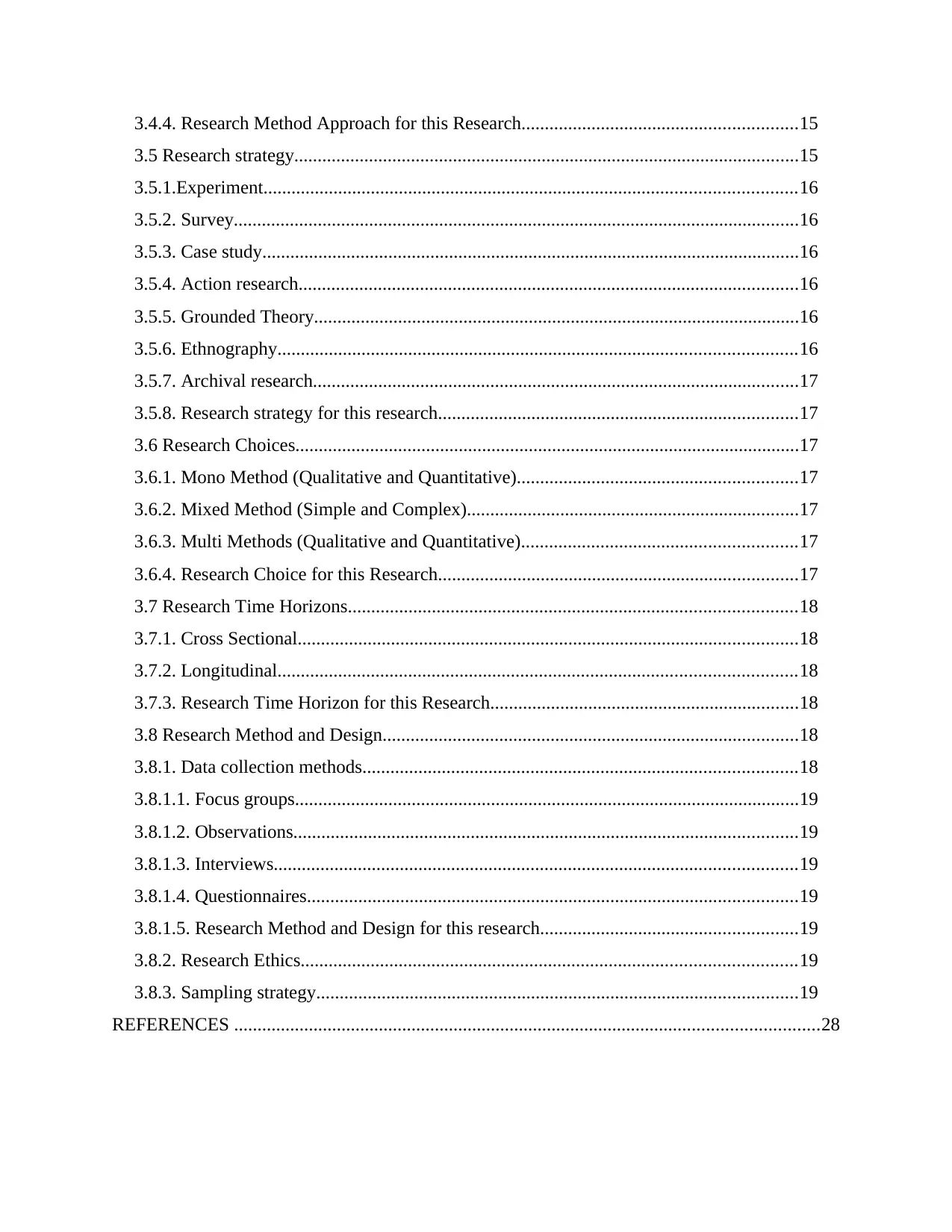
3.4.4. Research Method Approach for this Research...........................................................15
3.5 Research strategy............................................................................................................15
3.5.1.Experiment..................................................................................................................16
3.5.2. Survey.........................................................................................................................16
3.5.3. Case study...................................................................................................................16
3.5.4. Action research...........................................................................................................16
3.5.5. Grounded Theory........................................................................................................16
3.5.6. Ethnography...............................................................................................................16
3.5.7. Archival research........................................................................................................17
3.5.8. Research strategy for this research.............................................................................17
3.6 Research Choices............................................................................................................17
3.6.1. Mono Method (Qualitative and Quantitative)............................................................17
3.6.2. Mixed Method (Simple and Complex).......................................................................17
3.6.3. Multi Methods (Qualitative and Quantitative)...........................................................17
3.6.4. Research Choice for this Research.............................................................................17
3.7 Research Time Horizons................................................................................................18
3.7.1. Cross Sectional...........................................................................................................18
3.7.2. Longitudinal...............................................................................................................18
3.7.3. Research Time Horizon for this Research..................................................................18
3.8 Research Method and Design.........................................................................................18
3.8.1. Data collection methods.............................................................................................18
3.8.1.1. Focus groups............................................................................................................19
3.8.1.2. Observations............................................................................................................19
3.8.1.3. Interviews................................................................................................................19
3.8.1.4. Questionnaires.........................................................................................................19
3.8.1.5. Research Method and Design for this research.......................................................19
3.8.2. Research Ethics..........................................................................................................19
3.8.3. Sampling strategy.......................................................................................................19
REFERENCES .............................................................................................................................28
3.5 Research strategy............................................................................................................15
3.5.1.Experiment..................................................................................................................16
3.5.2. Survey.........................................................................................................................16
3.5.3. Case study...................................................................................................................16
3.5.4. Action research...........................................................................................................16
3.5.5. Grounded Theory........................................................................................................16
3.5.6. Ethnography...............................................................................................................16
3.5.7. Archival research........................................................................................................17
3.5.8. Research strategy for this research.............................................................................17
3.6 Research Choices............................................................................................................17
3.6.1. Mono Method (Qualitative and Quantitative)............................................................17
3.6.2. Mixed Method (Simple and Complex).......................................................................17
3.6.3. Multi Methods (Qualitative and Quantitative)...........................................................17
3.6.4. Research Choice for this Research.............................................................................17
3.7 Research Time Horizons................................................................................................18
3.7.1. Cross Sectional...........................................................................................................18
3.7.2. Longitudinal...............................................................................................................18
3.7.3. Research Time Horizon for this Research..................................................................18
3.8 Research Method and Design.........................................................................................18
3.8.1. Data collection methods.............................................................................................18
3.8.1.1. Focus groups............................................................................................................19
3.8.1.2. Observations............................................................................................................19
3.8.1.3. Interviews................................................................................................................19
3.8.1.4. Questionnaires.........................................................................................................19
3.8.1.5. Research Method and Design for this research.......................................................19
3.8.2. Research Ethics..........................................................................................................19
3.8.3. Sampling strategy.......................................................................................................19
REFERENCES .............................................................................................................................28
⊘ This is a preview!⊘
Do you want full access?
Subscribe today to unlock all pages.

Trusted by 1+ million students worldwide
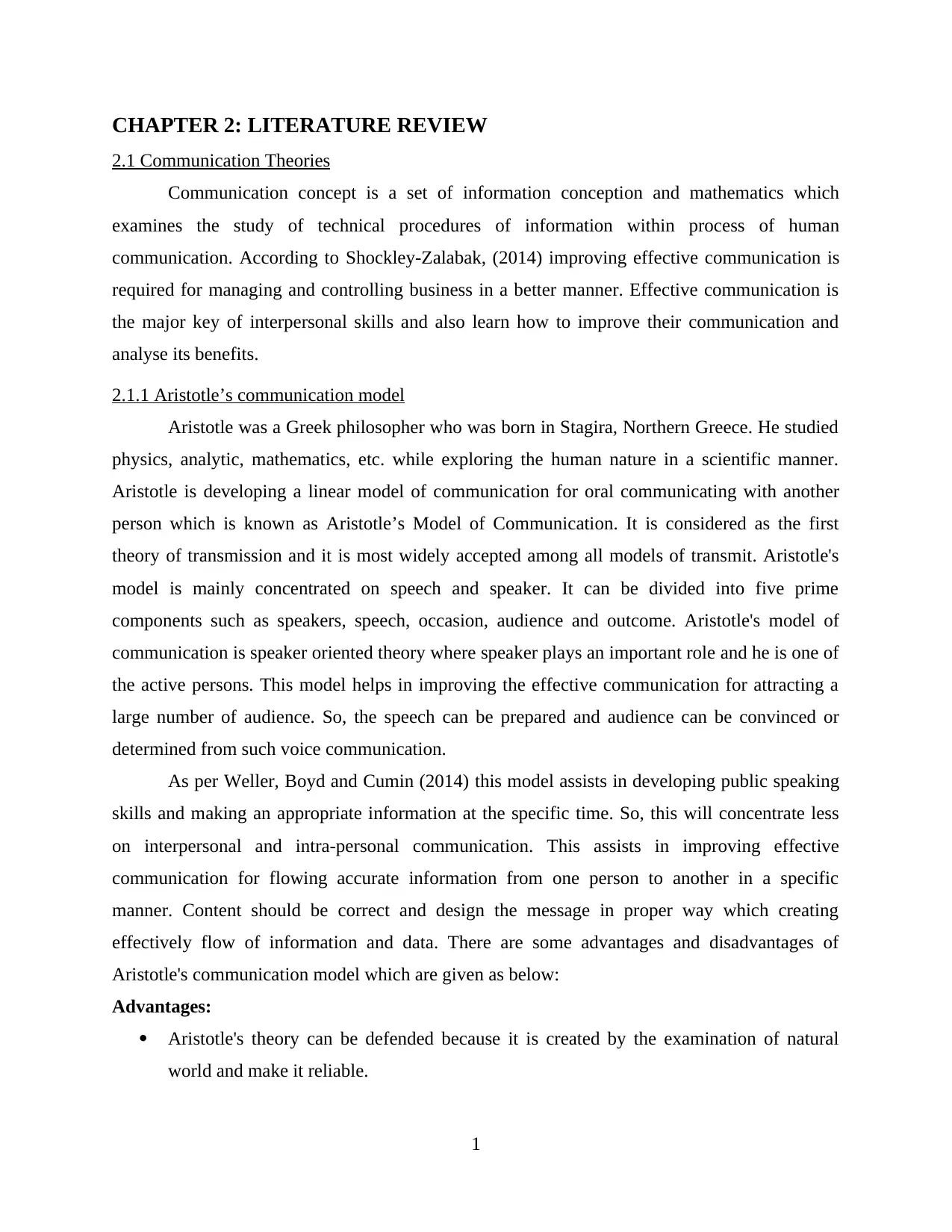
CHAPTER 2: LITERATURE REVIEW
2.1 Communication Theories
Communication concept is a set of information conception and mathematics which
examines the study of technical procedures of information within process of human
communication. According to Shockley-Zalabak, (2014) improving effective communication is
required for managing and controlling business in a better manner. Effective communication is
the major key of interpersonal skills and also learn how to improve their communication and
analyse its benefits.
2.1.1 Aristotle’s communication model
Aristotle was a Greek philosopher who was born in Stagira, Northern Greece. He studied
physics, analytic, mathematics, etc. while exploring the human nature in a scientific manner.
Aristotle is developing a linear model of communication for oral communicating with another
person which is known as Aristotle’s Model of Communication. It is considered as the first
theory of transmission and it is most widely accepted among all models of transmit. Aristotle's
model is mainly concentrated on speech and speaker. It can be divided into five prime
components such as speakers, speech, occasion, audience and outcome. Aristotle's model of
communication is speaker oriented theory where speaker plays an important role and he is one of
the active persons. This model helps in improving the effective communication for attracting a
large number of audience. So, the speech can be prepared and audience can be convinced or
determined from such voice communication.
As per Weller, Boyd and Cumin (2014) this model assists in developing public speaking
skills and making an appropriate information at the specific time. So, this will concentrate less
on interpersonal and intra-personal communication. This assists in improving effective
communication for flowing accurate information from one person to another in a specific
manner. Content should be correct and design the message in proper way which creating
effectively flow of information and data. There are some advantages and disadvantages of
Aristotle's communication model which are given as below:
Advantages:
Aristotle's theory can be defended because it is created by the examination of natural
world and make it reliable.
1
2.1 Communication Theories
Communication concept is a set of information conception and mathematics which
examines the study of technical procedures of information within process of human
communication. According to Shockley-Zalabak, (2014) improving effective communication is
required for managing and controlling business in a better manner. Effective communication is
the major key of interpersonal skills and also learn how to improve their communication and
analyse its benefits.
2.1.1 Aristotle’s communication model
Aristotle was a Greek philosopher who was born in Stagira, Northern Greece. He studied
physics, analytic, mathematics, etc. while exploring the human nature in a scientific manner.
Aristotle is developing a linear model of communication for oral communicating with another
person which is known as Aristotle’s Model of Communication. It is considered as the first
theory of transmission and it is most widely accepted among all models of transmit. Aristotle's
model is mainly concentrated on speech and speaker. It can be divided into five prime
components such as speakers, speech, occasion, audience and outcome. Aristotle's model of
communication is speaker oriented theory where speaker plays an important role and he is one of
the active persons. This model helps in improving the effective communication for attracting a
large number of audience. So, the speech can be prepared and audience can be convinced or
determined from such voice communication.
As per Weller, Boyd and Cumin (2014) this model assists in developing public speaking
skills and making an appropriate information at the specific time. So, this will concentrate less
on interpersonal and intra-personal communication. This assists in improving effective
communication for flowing accurate information from one person to another in a specific
manner. Content should be correct and design the message in proper way which creating
effectively flow of information and data. There are some advantages and disadvantages of
Aristotle's communication model which are given as below:
Advantages:
Aristotle's theory can be defended because it is created by the examination of natural
world and make it reliable.
1
Paraphrase This Document
Need a fresh take? Get an instant paraphrase of this document with our AI Paraphraser
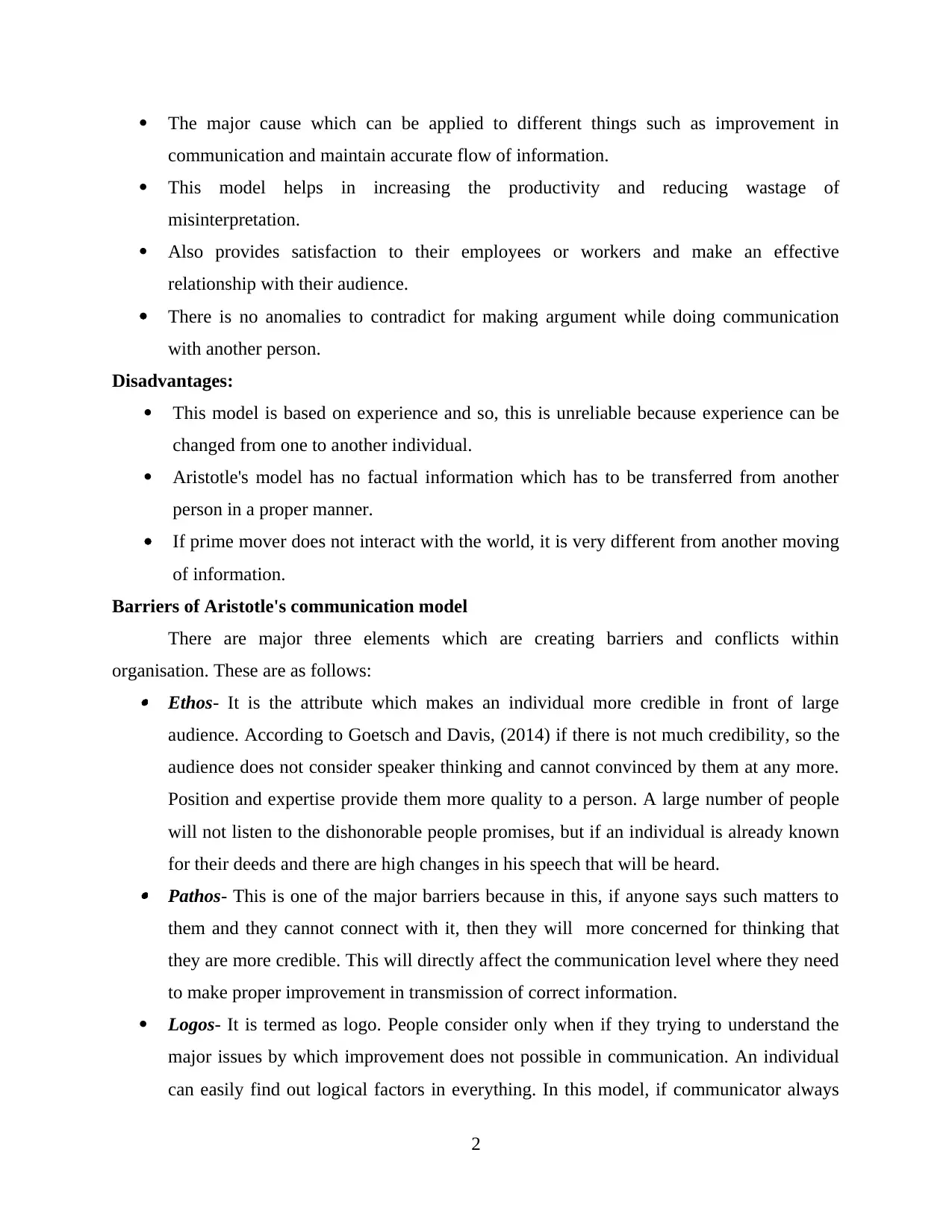
The major cause which can be applied to different things such as improvement in
communication and maintain accurate flow of information.
This model helps in increasing the productivity and reducing wastage of
misinterpretation.
Also provides satisfaction to their employees or workers and make an effective
relationship with their audience.
There is no anomalies to contradict for making argument while doing communication
with another person.
Disadvantages:
This model is based on experience and so, this is unreliable because experience can be
changed from one to another individual.
Aristotle's model has no factual information which has to be transferred from another
person in a proper manner.
If prime mover does not interact with the world, it is very different from another moving
of information.
Barriers of Aristotle's communication model
There are major three elements which are creating barriers and conflicts within
organisation. These are as follows: Ethos- It is the attribute which makes an individual more credible in front of large
audience. According to Goetsch and Davis, (2014) if there is not much credibility, so the
audience does not consider speaker thinking and cannot convinced by them at any more.
Position and expertise provide them more quality to a person. A large number of people
will not listen to the dishonorable people promises, but if an individual is already known
for their deeds and there are high changes in his speech that will be heard. Pathos- This is one of the major barriers because in this, if anyone says such matters to
them and they cannot connect with it, then they will more concerned for thinking that
they are more credible. This will directly affect the communication level where they need
to make proper improvement in transmission of correct information.
Logos- It is termed as logo. People consider only when if they trying to understand the
major issues by which improvement does not possible in communication. An individual
can easily find out logical factors in everything. In this model, if communicator always
2
communication and maintain accurate flow of information.
This model helps in increasing the productivity and reducing wastage of
misinterpretation.
Also provides satisfaction to their employees or workers and make an effective
relationship with their audience.
There is no anomalies to contradict for making argument while doing communication
with another person.
Disadvantages:
This model is based on experience and so, this is unreliable because experience can be
changed from one to another individual.
Aristotle's model has no factual information which has to be transferred from another
person in a proper manner.
If prime mover does not interact with the world, it is very different from another moving
of information.
Barriers of Aristotle's communication model
There are major three elements which are creating barriers and conflicts within
organisation. These are as follows: Ethos- It is the attribute which makes an individual more credible in front of large
audience. According to Goetsch and Davis, (2014) if there is not much credibility, so the
audience does not consider speaker thinking and cannot convinced by them at any more.
Position and expertise provide them more quality to a person. A large number of people
will not listen to the dishonorable people promises, but if an individual is already known
for their deeds and there are high changes in his speech that will be heard. Pathos- This is one of the major barriers because in this, if anyone says such matters to
them and they cannot connect with it, then they will more concerned for thinking that
they are more credible. This will directly affect the communication level where they need
to make proper improvement in transmission of correct information.
Logos- It is termed as logo. People consider only when if they trying to understand the
major issues by which improvement does not possible in communication. An individual
can easily find out logical factors in everything. In this model, if communicator always
2
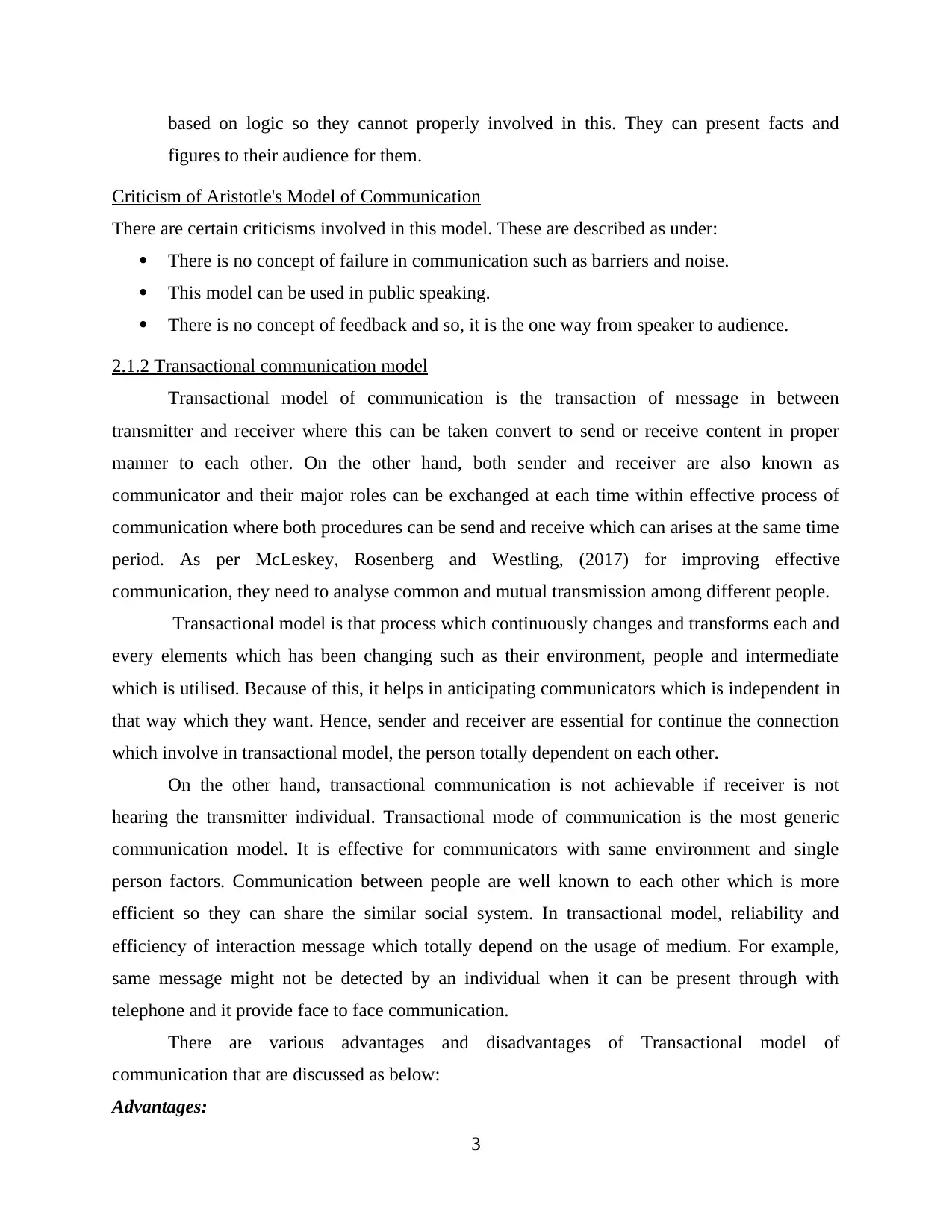
based on logic so they cannot properly involved in this. They can present facts and
figures to their audience for them.
Criticism of Aristotle's Model of Communication
There are certain criticisms involved in this model. These are described as under:
There is no concept of failure in communication such as barriers and noise.
This model can be used in public speaking.
There is no concept of feedback and so, it is the one way from speaker to audience.
2.1.2 Transactional communication model
Transactional model of communication is the transaction of message in between
transmitter and receiver where this can be taken convert to send or receive content in proper
manner to each other. On the other hand, both sender and receiver are also known as
communicator and their major roles can be exchanged at each time within effective process of
communication where both procedures can be send and receive which can arises at the same time
period. As per McLeskey, Rosenberg and Westling, (2017) for improving effective
communication, they need to analyse common and mutual transmission among different people.
Transactional model is that process which continuously changes and transforms each and
every elements which has been changing such as their environment, people and intermediate
which is utilised. Because of this, it helps in anticipating communicators which is independent in
that way which they want. Hence, sender and receiver are essential for continue the connection
which involve in transactional model, the person totally dependent on each other.
On the other hand, transactional communication is not achievable if receiver is not
hearing the transmitter individual. Transactional mode of communication is the most generic
communication model. It is effective for communicators with same environment and single
person factors. Communication between people are well known to each other which is more
efficient so they can share the similar social system. In transactional model, reliability and
efficiency of interaction message which totally depend on the usage of medium. For example,
same message might not be detected by an individual when it can be present through with
telephone and it provide face to face communication.
There are various advantages and disadvantages of Transactional model of
communication that are discussed as below:
Advantages:
3
figures to their audience for them.
Criticism of Aristotle's Model of Communication
There are certain criticisms involved in this model. These are described as under:
There is no concept of failure in communication such as barriers and noise.
This model can be used in public speaking.
There is no concept of feedback and so, it is the one way from speaker to audience.
2.1.2 Transactional communication model
Transactional model of communication is the transaction of message in between
transmitter and receiver where this can be taken convert to send or receive content in proper
manner to each other. On the other hand, both sender and receiver are also known as
communicator and their major roles can be exchanged at each time within effective process of
communication where both procedures can be send and receive which can arises at the same time
period. As per McLeskey, Rosenberg and Westling, (2017) for improving effective
communication, they need to analyse common and mutual transmission among different people.
Transactional model is that process which continuously changes and transforms each and
every elements which has been changing such as their environment, people and intermediate
which is utilised. Because of this, it helps in anticipating communicators which is independent in
that way which they want. Hence, sender and receiver are essential for continue the connection
which involve in transactional model, the person totally dependent on each other.
On the other hand, transactional communication is not achievable if receiver is not
hearing the transmitter individual. Transactional mode of communication is the most generic
communication model. It is effective for communicators with same environment and single
person factors. Communication between people are well known to each other which is more
efficient so they can share the similar social system. In transactional model, reliability and
efficiency of interaction message which totally depend on the usage of medium. For example,
same message might not be detected by an individual when it can be present through with
telephone and it provide face to face communication.
There are various advantages and disadvantages of Transactional model of
communication that are discussed as below:
Advantages:
3
⊘ This is a preview!⊘
Do you want full access?
Subscribe today to unlock all pages.

Trusted by 1+ million students worldwide
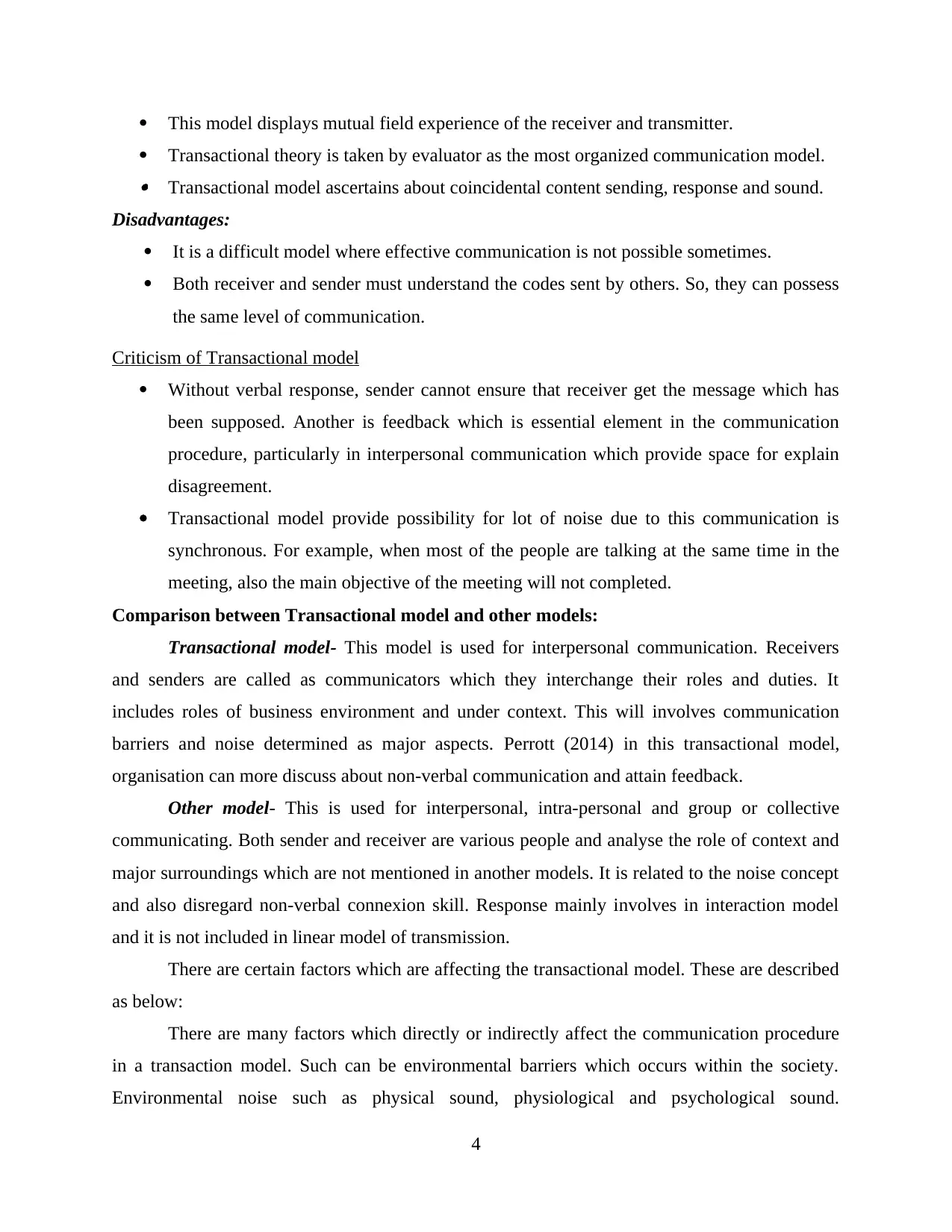
This model displays mutual field experience of the receiver and transmitter.
Transactional theory is taken by evaluator as the most organized communication model. Transactional model ascertains about coincidental content sending, response and sound.
Disadvantages:
It is a difficult model where effective communication is not possible sometimes.
Both receiver and sender must understand the codes sent by others. So, they can possess
the same level of communication.
Criticism of Transactional model
Without verbal response, sender cannot ensure that receiver get the message which has
been supposed. Another is feedback which is essential element in the communication
procedure, particularly in interpersonal communication which provide space for explain
disagreement.
Transactional model provide possibility for lot of noise due to this communication is
synchronous. For example, when most of the people are talking at the same time in the
meeting, also the main objective of the meeting will not completed.
Comparison between Transactional model and other models:
Transactional model- This model is used for interpersonal communication. Receivers
and senders are called as communicators which they interchange their roles and duties. It
includes roles of business environment and under context. This will involves communication
barriers and noise determined as major aspects. Perrott (2014) in this transactional model,
organisation can more discuss about non-verbal communication and attain feedback.
Other model- This is used for interpersonal, intra-personal and group or collective
communicating. Both sender and receiver are various people and analyse the role of context and
major surroundings which are not mentioned in another models. It is related to the noise concept
and also disregard non-verbal connexion skill. Response mainly involves in interaction model
and it is not included in linear model of transmission.
There are certain factors which are affecting the transactional model. These are described
as below:
There are many factors which directly or indirectly affect the communication procedure
in a transaction model. Such can be environmental barriers which occurs within the society.
Environmental noise such as physical sound, physiological and psychological sound.
4
Transactional theory is taken by evaluator as the most organized communication model. Transactional model ascertains about coincidental content sending, response and sound.
Disadvantages:
It is a difficult model where effective communication is not possible sometimes.
Both receiver and sender must understand the codes sent by others. So, they can possess
the same level of communication.
Criticism of Transactional model
Without verbal response, sender cannot ensure that receiver get the message which has
been supposed. Another is feedback which is essential element in the communication
procedure, particularly in interpersonal communication which provide space for explain
disagreement.
Transactional model provide possibility for lot of noise due to this communication is
synchronous. For example, when most of the people are talking at the same time in the
meeting, also the main objective of the meeting will not completed.
Comparison between Transactional model and other models:
Transactional model- This model is used for interpersonal communication. Receivers
and senders are called as communicators which they interchange their roles and duties. It
includes roles of business environment and under context. This will involves communication
barriers and noise determined as major aspects. Perrott (2014) in this transactional model,
organisation can more discuss about non-verbal communication and attain feedback.
Other model- This is used for interpersonal, intra-personal and group or collective
communicating. Both sender and receiver are various people and analyse the role of context and
major surroundings which are not mentioned in another models. It is related to the noise concept
and also disregard non-verbal connexion skill. Response mainly involves in interaction model
and it is not included in linear model of transmission.
There are certain factors which are affecting the transactional model. These are described
as below:
There are many factors which directly or indirectly affect the communication procedure
in a transaction model. Such can be environmental barriers which occurs within the society.
Environmental noise such as physical sound, physiological and psychological sound.
4
Paraphrase This Document
Need a fresh take? Get an instant paraphrase of this document with our AI Paraphraser
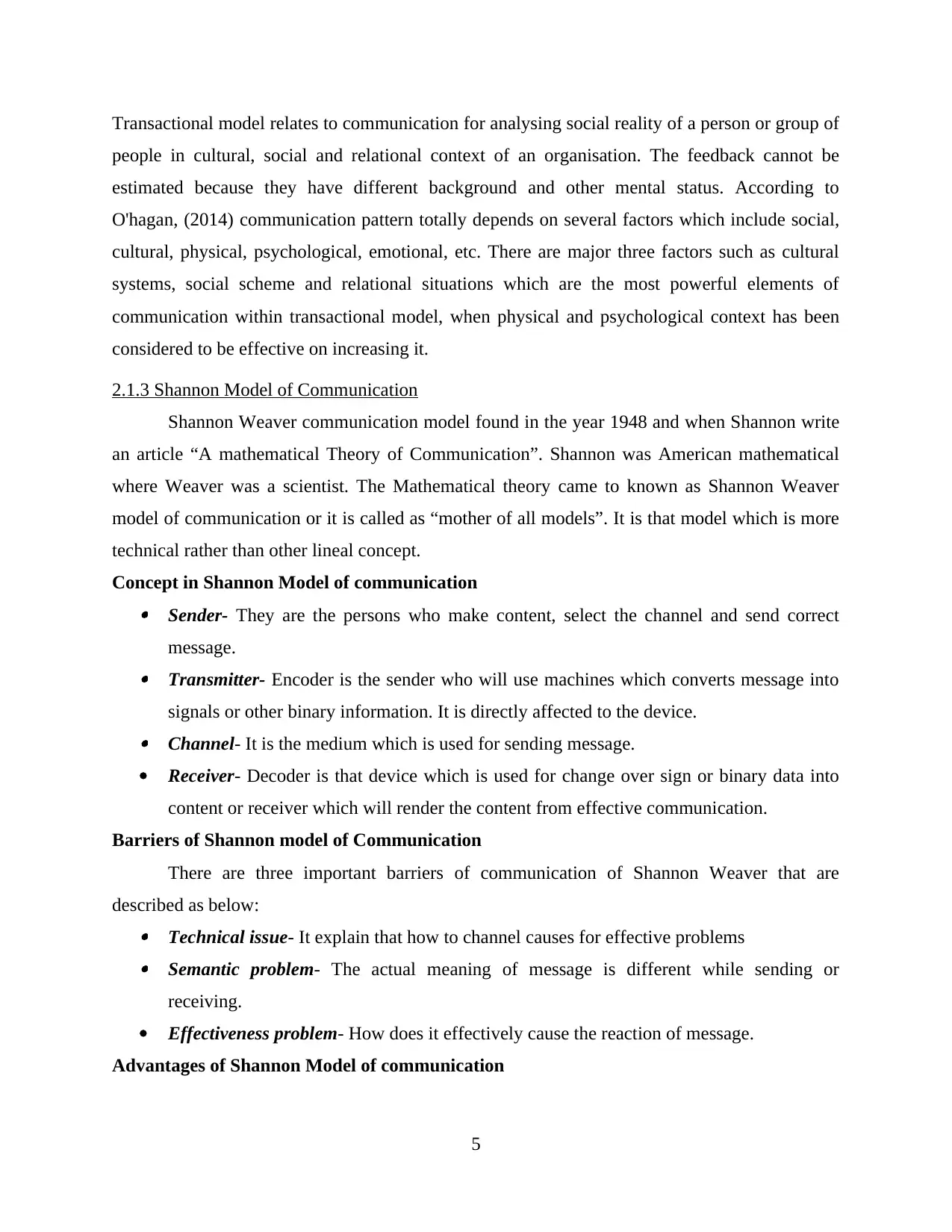
Transactional model relates to communication for analysing social reality of a person or group of
people in cultural, social and relational context of an organisation. The feedback cannot be
estimated because they have different background and other mental status. According to
O'hagan, (2014) communication pattern totally depends on several factors which include social,
cultural, physical, psychological, emotional, etc. There are major three factors such as cultural
systems, social scheme and relational situations which are the most powerful elements of
communication within transactional model, when physical and psychological context has been
considered to be effective on increasing it.
2.1.3 Shannon Model of Communication
Shannon Weaver communication model found in the year 1948 and when Shannon write
an article “A mathematical Theory of Communication”. Shannon was American mathematical
where Weaver was a scientist. The Mathematical theory came to known as Shannon Weaver
model of communication or it is called as “mother of all models”. It is that model which is more
technical rather than other lineal concept.
Concept in Shannon Model of communication Sender- They are the persons who make content, select the channel and send correct
message. Transmitter- Encoder is the sender who will use machines which converts message into
signals or other binary information. It is directly affected to the device. Channel- It is the medium which is used for sending message.
Receiver- Decoder is that device which is used for change over sign or binary data into
content or receiver which will render the content from effective communication.
Barriers of Shannon model of Communication
There are three important barriers of communication of Shannon Weaver that are
described as below: Technical issue- It explain that how to channel causes for effective problems Semantic problem- The actual meaning of message is different while sending or
receiving.
Effectiveness problem- How does it effectively cause the reaction of message.
Advantages of Shannon Model of communication
5
people in cultural, social and relational context of an organisation. The feedback cannot be
estimated because they have different background and other mental status. According to
O'hagan, (2014) communication pattern totally depends on several factors which include social,
cultural, physical, psychological, emotional, etc. There are major three factors such as cultural
systems, social scheme and relational situations which are the most powerful elements of
communication within transactional model, when physical and psychological context has been
considered to be effective on increasing it.
2.1.3 Shannon Model of Communication
Shannon Weaver communication model found in the year 1948 and when Shannon write
an article “A mathematical Theory of Communication”. Shannon was American mathematical
where Weaver was a scientist. The Mathematical theory came to known as Shannon Weaver
model of communication or it is called as “mother of all models”. It is that model which is more
technical rather than other lineal concept.
Concept in Shannon Model of communication Sender- They are the persons who make content, select the channel and send correct
message. Transmitter- Encoder is the sender who will use machines which converts message into
signals or other binary information. It is directly affected to the device. Channel- It is the medium which is used for sending message.
Receiver- Decoder is that device which is used for change over sign or binary data into
content or receiver which will render the content from effective communication.
Barriers of Shannon model of Communication
There are three important barriers of communication of Shannon Weaver that are
described as below: Technical issue- It explain that how to channel causes for effective problems Semantic problem- The actual meaning of message is different while sending or
receiving.
Effectiveness problem- How does it effectively cause the reaction of message.
Advantages of Shannon Model of communication
5
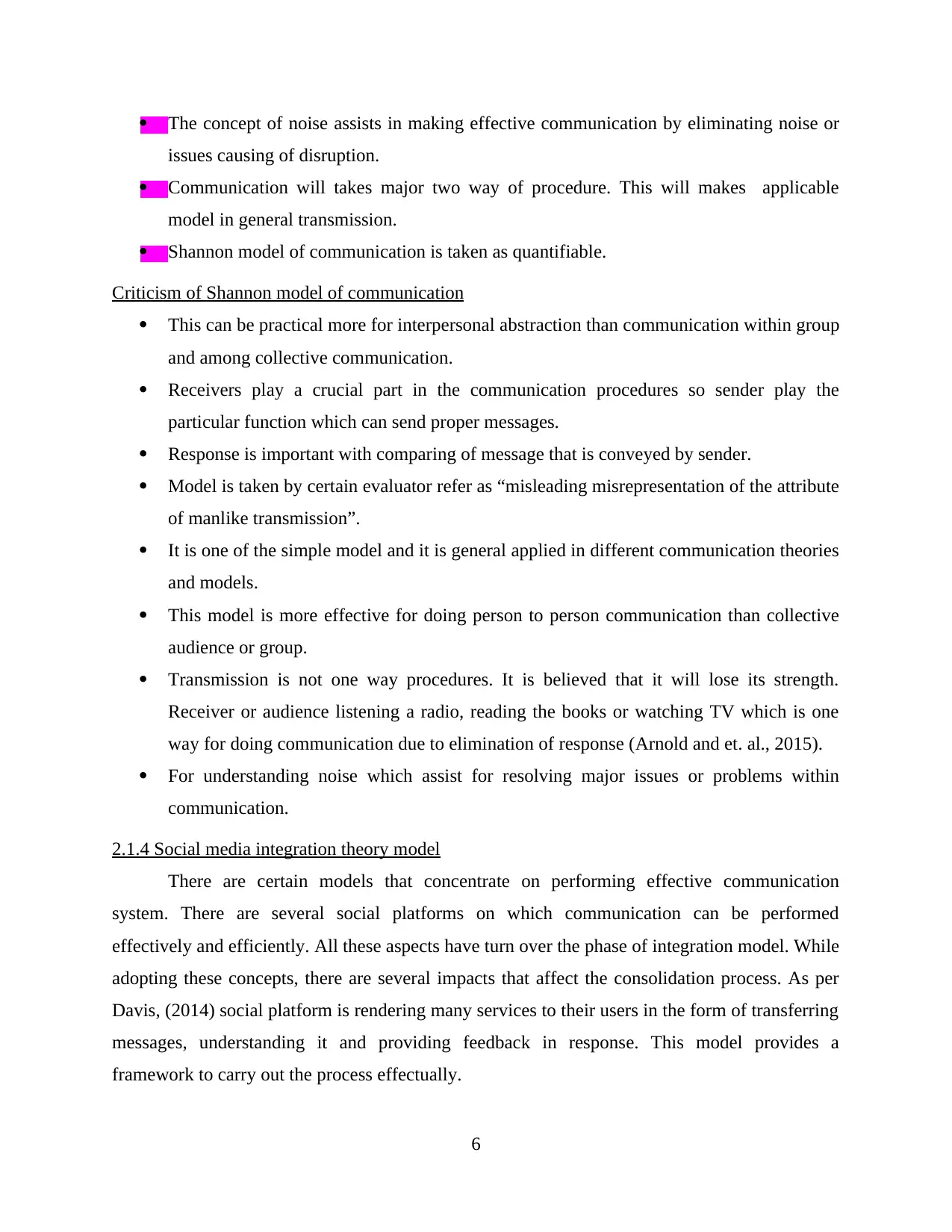
The concept of noise assists in making effective communication by eliminating noise or
issues causing of disruption.
Communication will takes major two way of procedure. This will makes applicable
model in general transmission.
Shannon model of communication is taken as quantifiable.
Criticism of Shannon model of communication
This can be practical more for interpersonal abstraction than communication within group
and among collective communication.
Receivers play a crucial part in the communication procedures so sender play the
particular function which can send proper messages.
Response is important with comparing of message that is conveyed by sender.
Model is taken by certain evaluator refer as “misleading misrepresentation of the attribute
of manlike transmission”.
It is one of the simple model and it is general applied in different communication theories
and models.
This model is more effective for doing person to person communication than collective
audience or group.
Transmission is not one way procedures. It is believed that it will lose its strength.
Receiver or audience listening a radio, reading the books or watching TV which is one
way for doing communication due to elimination of response (Arnold and et. al., 2015).
For understanding noise which assist for resolving major issues or problems within
communication.
2.1.4 Social media integration theory model
There are certain models that concentrate on performing effective communication
system. There are several social platforms on which communication can be performed
effectively and efficiently. All these aspects have turn over the phase of integration model. While
adopting these concepts, there are several impacts that affect the consolidation process. As per
Davis, (2014) social platform is rendering many services to their users in the form of transferring
messages, understanding it and providing feedback in response. This model provides a
framework to carry out the process effectually.
6
issues causing of disruption.
Communication will takes major two way of procedure. This will makes applicable
model in general transmission.
Shannon model of communication is taken as quantifiable.
Criticism of Shannon model of communication
This can be practical more for interpersonal abstraction than communication within group
and among collective communication.
Receivers play a crucial part in the communication procedures so sender play the
particular function which can send proper messages.
Response is important with comparing of message that is conveyed by sender.
Model is taken by certain evaluator refer as “misleading misrepresentation of the attribute
of manlike transmission”.
It is one of the simple model and it is general applied in different communication theories
and models.
This model is more effective for doing person to person communication than collective
audience or group.
Transmission is not one way procedures. It is believed that it will lose its strength.
Receiver or audience listening a radio, reading the books or watching TV which is one
way for doing communication due to elimination of response (Arnold and et. al., 2015).
For understanding noise which assist for resolving major issues or problems within
communication.
2.1.4 Social media integration theory model
There are certain models that concentrate on performing effective communication
system. There are several social platforms on which communication can be performed
effectively and efficiently. All these aspects have turn over the phase of integration model. While
adopting these concepts, there are several impacts that affect the consolidation process. As per
Davis, (2014) social platform is rendering many services to their users in the form of transferring
messages, understanding it and providing feedback in response. This model provides a
framework to carry out the process effectually.
6
⊘ This is a preview!⊘
Do you want full access?
Subscribe today to unlock all pages.

Trusted by 1+ million students worldwide
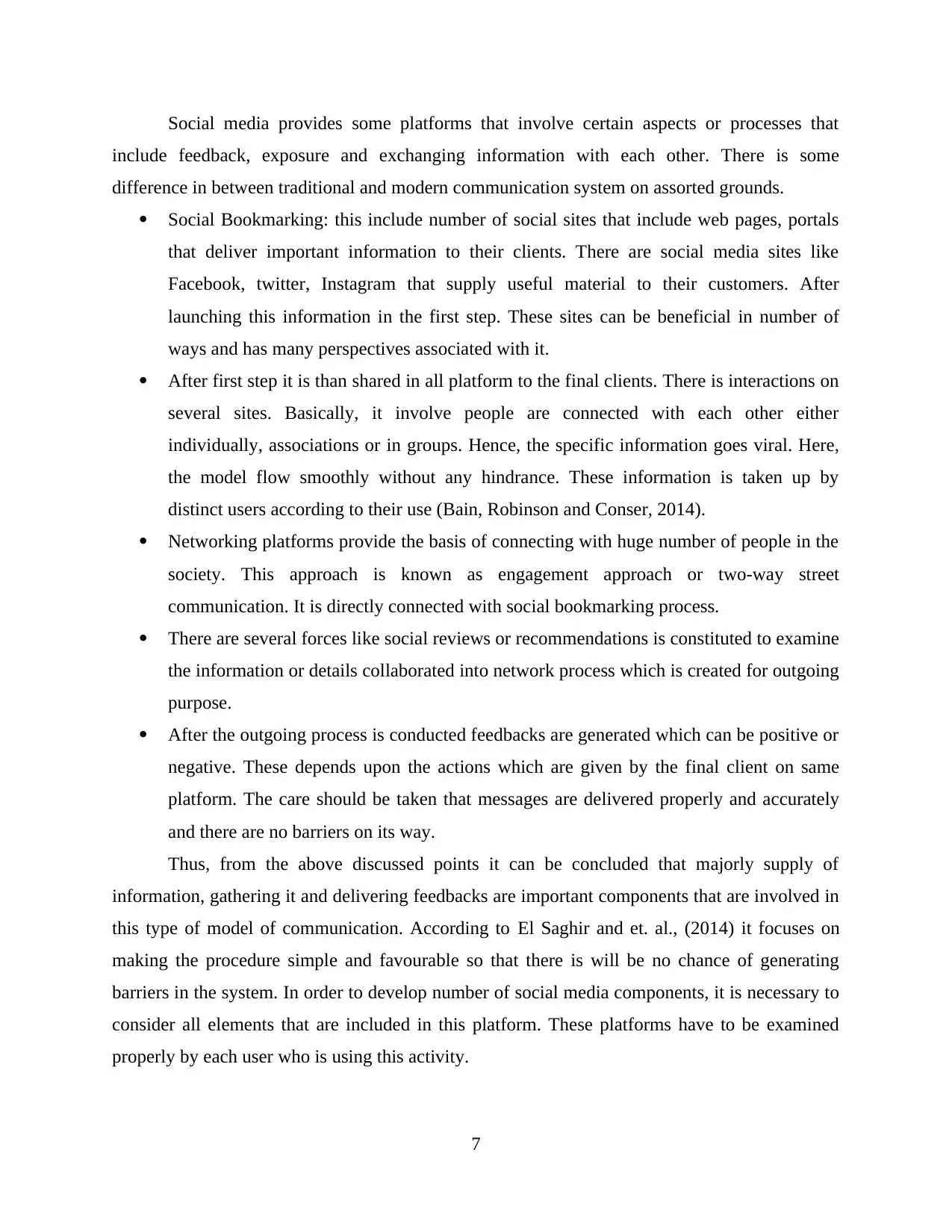
Social media provides some platforms that involve certain aspects or processes that
include feedback, exposure and exchanging information with each other. There is some
difference in between traditional and modern communication system on assorted grounds.
Social Bookmarking: this include number of social sites that include web pages, portals
that deliver important information to their clients. There are social media sites like
Facebook, twitter, Instagram that supply useful material to their customers. After
launching this information in the first step. These sites can be beneficial in number of
ways and has many perspectives associated with it.
After first step it is than shared in all platform to the final clients. There is interactions on
several sites. Basically, it involve people are connected with each other either
individually, associations or in groups. Hence, the specific information goes viral. Here,
the model flow smoothly without any hindrance. These information is taken up by
distinct users according to their use (Bain, Robinson and Conser, 2014).
Networking platforms provide the basis of connecting with huge number of people in the
society. This approach is known as engagement approach or two-way street
communication. It is directly connected with social bookmarking process.
There are several forces like social reviews or recommendations is constituted to examine
the information or details collaborated into network process which is created for outgoing
purpose.
After the outgoing process is conducted feedbacks are generated which can be positive or
negative. These depends upon the actions which are given by the final client on same
platform. The care should be taken that messages are delivered properly and accurately
and there are no barriers on its way.
Thus, from the above discussed points it can be concluded that majorly supply of
information, gathering it and delivering feedbacks are important components that are involved in
this type of model of communication. According to El Saghir and et. al., (2014) it focuses on
making the procedure simple and favourable so that there is will be no chance of generating
barriers in the system. In order to develop number of social media components, it is necessary to
consider all elements that are included in this platform. These platforms have to be examined
properly by each user who is using this activity.
7
include feedback, exposure and exchanging information with each other. There is some
difference in between traditional and modern communication system on assorted grounds.
Social Bookmarking: this include number of social sites that include web pages, portals
that deliver important information to their clients. There are social media sites like
Facebook, twitter, Instagram that supply useful material to their customers. After
launching this information in the first step. These sites can be beneficial in number of
ways and has many perspectives associated with it.
After first step it is than shared in all platform to the final clients. There is interactions on
several sites. Basically, it involve people are connected with each other either
individually, associations or in groups. Hence, the specific information goes viral. Here,
the model flow smoothly without any hindrance. These information is taken up by
distinct users according to their use (Bain, Robinson and Conser, 2014).
Networking platforms provide the basis of connecting with huge number of people in the
society. This approach is known as engagement approach or two-way street
communication. It is directly connected with social bookmarking process.
There are several forces like social reviews or recommendations is constituted to examine
the information or details collaborated into network process which is created for outgoing
purpose.
After the outgoing process is conducted feedbacks are generated which can be positive or
negative. These depends upon the actions which are given by the final client on same
platform. The care should be taken that messages are delivered properly and accurately
and there are no barriers on its way.
Thus, from the above discussed points it can be concluded that majorly supply of
information, gathering it and delivering feedbacks are important components that are involved in
this type of model of communication. According to El Saghir and et. al., (2014) it focuses on
making the procedure simple and favourable so that there is will be no chance of generating
barriers in the system. In order to develop number of social media components, it is necessary to
consider all elements that are included in this platform. These platforms have to be examined
properly by each user who is using this activity.
7
Paraphrase This Document
Need a fresh take? Get an instant paraphrase of this document with our AI Paraphraser
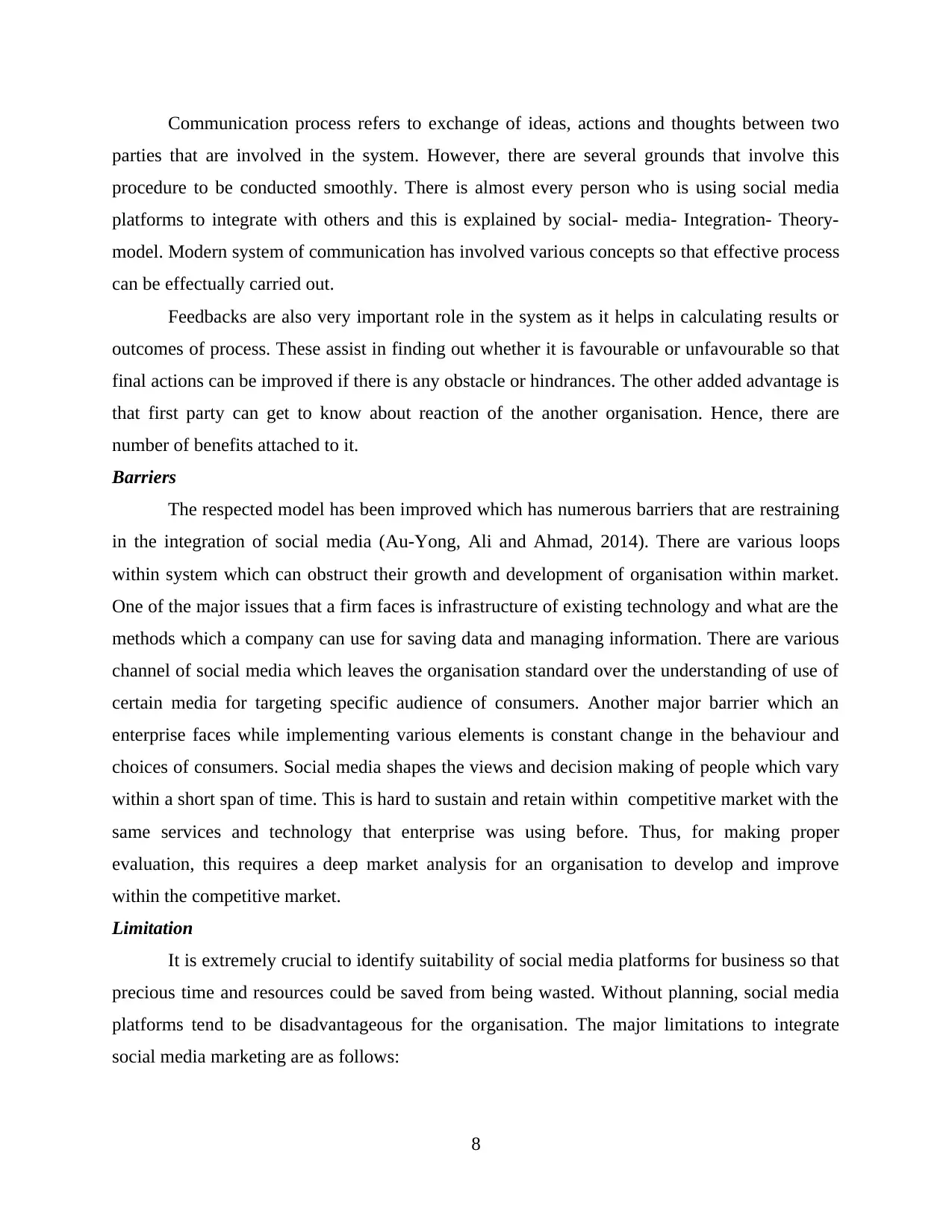
Communication process refers to exchange of ideas, actions and thoughts between two
parties that are involved in the system. However, there are several grounds that involve this
procedure to be conducted smoothly. There is almost every person who is using social media
platforms to integrate with others and this is explained by social- media- Integration- Theory-
model. Modern system of communication has involved various concepts so that effective process
can be effectually carried out.
Feedbacks are also very important role in the system as it helps in calculating results or
outcomes of process. These assist in finding out whether it is favourable or unfavourable so that
final actions can be improved if there is any obstacle or hindrances. The other added advantage is
that first party can get to know about reaction of the another organisation. Hence, there are
number of benefits attached to it.
Barriers
The respected model has been improved which has numerous barriers that are restraining
in the integration of social media (Au-Yong, Ali and Ahmad, 2014). There are various loops
within system which can obstruct their growth and development of organisation within market.
One of the major issues that a firm faces is infrastructure of existing technology and what are the
methods which a company can use for saving data and managing information. There are various
channel of social media which leaves the organisation standard over the understanding of use of
certain media for targeting specific audience of consumers. Another major barrier which an
enterprise faces while implementing various elements is constant change in the behaviour and
choices of consumers. Social media shapes the views and decision making of people which vary
within a short span of time. This is hard to sustain and retain within competitive market with the
same services and technology that enterprise was using before. Thus, for making proper
evaluation, this requires a deep market analysis for an organisation to develop and improve
within the competitive market.
Limitation
It is extremely crucial to identify suitability of social media platforms for business so that
precious time and resources could be saved from being wasted. Without planning, social media
platforms tend to be disadvantageous for the organisation. The major limitations to integrate
social media marketing are as follows:
8
parties that are involved in the system. However, there are several grounds that involve this
procedure to be conducted smoothly. There is almost every person who is using social media
platforms to integrate with others and this is explained by social- media- Integration- Theory-
model. Modern system of communication has involved various concepts so that effective process
can be effectually carried out.
Feedbacks are also very important role in the system as it helps in calculating results or
outcomes of process. These assist in finding out whether it is favourable or unfavourable so that
final actions can be improved if there is any obstacle or hindrances. The other added advantage is
that first party can get to know about reaction of the another organisation. Hence, there are
number of benefits attached to it.
Barriers
The respected model has been improved which has numerous barriers that are restraining
in the integration of social media (Au-Yong, Ali and Ahmad, 2014). There are various loops
within system which can obstruct their growth and development of organisation within market.
One of the major issues that a firm faces is infrastructure of existing technology and what are the
methods which a company can use for saving data and managing information. There are various
channel of social media which leaves the organisation standard over the understanding of use of
certain media for targeting specific audience of consumers. Another major barrier which an
enterprise faces while implementing various elements is constant change in the behaviour and
choices of consumers. Social media shapes the views and decision making of people which vary
within a short span of time. This is hard to sustain and retain within competitive market with the
same services and technology that enterprise was using before. Thus, for making proper
evaluation, this requires a deep market analysis for an organisation to develop and improve
within the competitive market.
Limitation
It is extremely crucial to identify suitability of social media platforms for business so that
precious time and resources could be saved from being wasted. Without planning, social media
platforms tend to be disadvantageous for the organisation. The major limitations to integrate
social media marketing are as follows:
8
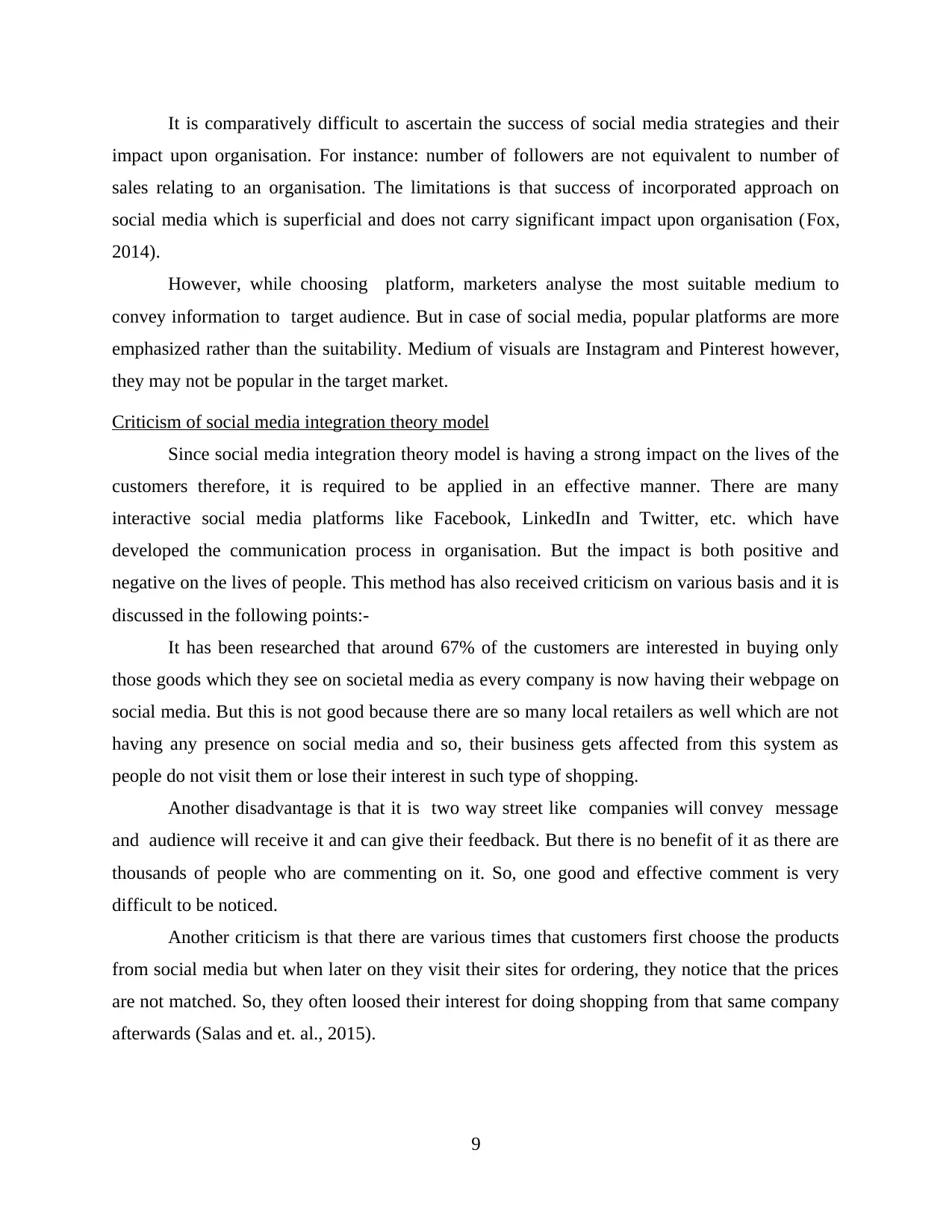
It is comparatively difficult to ascertain the success of social media strategies and their
impact upon organisation. For instance: number of followers are not equivalent to number of
sales relating to an organisation. The limitations is that success of incorporated approach on
social media which is superficial and does not carry significant impact upon organisation (Fox,
2014).
However, while choosing platform, marketers analyse the most suitable medium to
convey information to target audience. But in case of social media, popular platforms are more
emphasized rather than the suitability. Medium of visuals are Instagram and Pinterest however,
they may not be popular in the target market.
Criticism of social media integration theory model
Since social media integration theory model is having a strong impact on the lives of the
customers therefore, it is required to be applied in an effective manner. There are many
interactive social media platforms like Facebook, LinkedIn and Twitter, etc. which have
developed the communication process in organisation. But the impact is both positive and
negative on the lives of people. This method has also received criticism on various basis and it is
discussed in the following points:-
It has been researched that around 67% of the customers are interested in buying only
those goods which they see on societal media as every company is now having their webpage on
social media. But this is not good because there are so many local retailers as well which are not
having any presence on social media and so, their business gets affected from this system as
people do not visit them or lose their interest in such type of shopping.
Another disadvantage is that it is two way street like companies will convey message
and audience will receive it and can give their feedback. But there is no benefit of it as there are
thousands of people who are commenting on it. So, one good and effective comment is very
difficult to be noticed.
Another criticism is that there are various times that customers first choose the products
from social media but when later on they visit their sites for ordering, they notice that the prices
are not matched. So, they often loosed their interest for doing shopping from that same company
afterwards (Salas and et. al., 2015).
9
impact upon organisation. For instance: number of followers are not equivalent to number of
sales relating to an organisation. The limitations is that success of incorporated approach on
social media which is superficial and does not carry significant impact upon organisation (Fox,
2014).
However, while choosing platform, marketers analyse the most suitable medium to
convey information to target audience. But in case of social media, popular platforms are more
emphasized rather than the suitability. Medium of visuals are Instagram and Pinterest however,
they may not be popular in the target market.
Criticism of social media integration theory model
Since social media integration theory model is having a strong impact on the lives of the
customers therefore, it is required to be applied in an effective manner. There are many
interactive social media platforms like Facebook, LinkedIn and Twitter, etc. which have
developed the communication process in organisation. But the impact is both positive and
negative on the lives of people. This method has also received criticism on various basis and it is
discussed in the following points:-
It has been researched that around 67% of the customers are interested in buying only
those goods which they see on societal media as every company is now having their webpage on
social media. But this is not good because there are so many local retailers as well which are not
having any presence on social media and so, their business gets affected from this system as
people do not visit them or lose their interest in such type of shopping.
Another disadvantage is that it is two way street like companies will convey message
and audience will receive it and can give their feedback. But there is no benefit of it as there are
thousands of people who are commenting on it. So, one good and effective comment is very
difficult to be noticed.
Another criticism is that there are various times that customers first choose the products
from social media but when later on they visit their sites for ordering, they notice that the prices
are not matched. So, they often loosed their interest for doing shopping from that same company
afterwards (Salas and et. al., 2015).
9
⊘ This is a preview!⊘
Do you want full access?
Subscribe today to unlock all pages.

Trusted by 1+ million students worldwide
1 out of 31
Related Documents
Your All-in-One AI-Powered Toolkit for Academic Success.
+13062052269
info@desklib.com
Available 24*7 on WhatsApp / Email
![[object Object]](/_next/static/media/star-bottom.7253800d.svg)
Unlock your academic potential
Copyright © 2020–2025 A2Z Services. All Rights Reserved. Developed and managed by ZUCOL.





